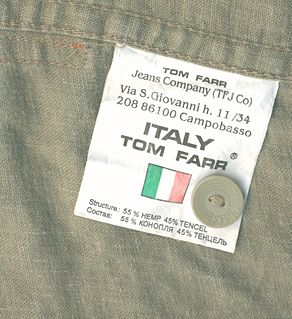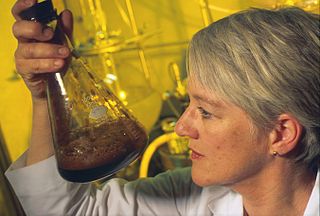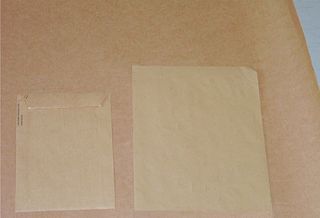
Pulp is a lignocellulosic fibrous material prepared by chemically or mechanically separating cellulose fibres from wood, fiber crops, waste paper, or rags. Many kinds of paper are made from wood with nothing else mixed into them. This includes newspapers, magazines and even toilet paper. Pulp is one of the most abundant raw materials.

Paperboard is a thick paper-based material. While there is no rigid differentiation between paper and paperboard, paperboard is generally thicker than paper and has certain superior attributes such as foldability and rigidity. According to ISO standards, paperboard is a paper with a grammage above 250 g/m2, but there are exceptions. Paperboard can be single- or multi-ply.
A paper machine is an industrial machine used in the pulp and paper industry to create paper in large quantities at high speed. Modern paper-making machines are based on the principles of the Fourdrinier Machine, which uses a moving woven mesh to create a continuous paper web by filtering out the fibres held in a paper stock and producing a continuously moving wet mat of fibre. This is dried in the machine to produce a strong paper web.

Lyocell is a form of rayon which consists of cellulose fibre made from dissolving pulp using dry jet-wet spinning. It was developed beginning in 1972 by a team at the now defunct American Enka fibers facility at Enka, North Carolina. This development was recognised by the American Association of Textile Chemists and Colorists (AATCC) in 2003 by the awarding of their Henry E. Millson Award for Invention. The operating name for the fibre inside the Enka Organization was "Newcell", and the development was carried through pilot plant scale before the work was halted. The fibre was developed further as Tencel in the 1980s by Courtaulds Fibres in Coventry, UK and at the Grimsby, UK pilot plant. The process was first commercialised at Courtaulds rayon factories at Mobile, Alabama (1990) and at the Grimsby plant (1998). In 1998, Courtaulds was acquired by Akzo Nobel, who combined the Tencel division with other fibre divisions under the Acordis banner, prior to selling them off to private equity. In 2000, CVC sold the Tencel division to Lenzing AG, who combined it with their "Lenzing Lyocell" business but maintained the brand name Tencel. As of 2017, Lenzing's Tencel brand is perhaps the most widely known lyocell fiber producer throughout the world.
The defibrator is a thermo mechanical pulping refiner in which the pulp material, such as wood chips, is ground in an environment of steam between a rotating grinding disc (rotor) and a stationary disc (stator) each with radial grooves that provides the grinding surface. Wood chips are fed into the centre and are broken down as the centrifugal force pushes them towards the circumference of the discs where the grooves are finer to produce wood fibre. The size of the refined fibres can to some extent be controlled by altering the distance between the discs where a closer distance produces finer fibres but also requires higher grinding force. The capacity per machine is largely determined by the size of the machine, as well as the motor speed 1500 rpm or 1800 rpm.

A pulp mill is a manufacturing facility that converts wood chips or other plant fibre source into a thick fibre board which can be shipped to a paper mill for further processing. Pulp can be manufactured using mechanical, semi-chemical or fully chemical methods. The finished product may be either bleached or non-bleached, depending on the customer requirements.

In industrial chemistry, black liquor is the waste product from the kraft process when digesting pulpwood into paper pulp removing lignin, hemicelluloses and other extractives from the wood to free the cellulose fibers.

Kraft paper or kraft is paper or paperboard (cardboard) produced from chemical pulp produced in the kraft process.
Bleaching of wood pulp is the chemical processing of wood pulp to lighten its color and whiten the pulp. The primary product of wood pulp is paper, for which whiteness is an important characteristic. These processes and chemistry are also applicable to the bleaching of non-wood pulps, such as those made from bamboo or kenaf.
The sulfite process produces wood pulp which is almost pure cellulose fibers by using various salts of sulfurous acid to extract the lignin from wood chips in large pressure vessels called digesters. The salts used in the pulping process are either sulfites (SO32−), or bisulfites (HSO3−), depending on the pH. The counter ion can be sodium (Na+), calcium (Ca2+), potassium (K+), magnesium (Mg2+) or ammonium (NH4+).

Paper is a thin material produced by pressing together moist fibres of cellulose pulp derived from wood, rags or grasses, and drying them into flexible sheets. It is a versatile material with many uses, including writing, printing, packaging, cleaning, decorating, and a number of industrial and construction processes. Papers are essential in legal or non-legal documentation.
Northern bleached softwood kraft (NBSK) is the paper industry's benchmark grade of pulp. Market NBSK is produced mainly in Canada and the Nordic countries. Some NBSK is also produced in north-western United States and in Russia. NBSK futures are traded on the Chicago Mercantile Exchange.
Dissolving pulp, also called dissolving cellulose, is bleached wood pulp or cotton linters that has a high cellulose content. It has special properties including a high level of brightness and uniform molecular-weight distribution. This pulp is manufactured for uses that require a high chemical purity, and particularly low hemicellulose content, since the chemically similar hemicellulose can interfere with subsequent processes. Dissolving pulp is so named because it is not made into paper, but dissolved either in a solvent or by derivatization into a homogeneous solution, which makes it completely chemically accessible and removes any remaining fibrous structure. Once dissolved, it can be spun into textile fibers, or chemically reacted to produce derivatized celluloses, such cellulose triacetate, a plastic-like material formed into fibers or films, or cellulose ethers such as methyl cellulose, used as a thickener.
Soda pulping is a chemical process for making wood pulp with sodium hydroxide as the cooking chemical. In the Soda-AQ process, anthraquinone (AQ) may be used as a pulping additive to decrease the carbohydrate degradation. The soda process gives pulp with lower tear strength than other chemical pulping processes, but has still limited use for easy pulped materials like straw and some hardwoods.
A shive is a small bundle of incompletely cooked wood fibres in the chemical pulp used in papermaking. They are smaller than knots and are more difficult to separate from the pulp. Typically the content of shives in kraft pulp is 0.1 to 1.0%. An excess of shives is a sign of poor impregnation of the wood chips. Shives are separated from the pulp in the screening and can be added back after refining. Even though shives are darker than rest of the pulp, they may pass unnoticed to the paper machine because they are easily bleached. Shives in the paper machine can cause web breakage or other operational problems. They might also end as spots in the finished paper.
White liquor is a strongly alkaline solution mainly of sodium hydroxide and sodium sulfide. It is used in the first stage of the Kraft process in which lignin and hemicellulose are separated from cellulose fiber for the production of pulp. The white liquor breaks the bonds between lignin and cellulose. It is called white liquor due to its white opaque colour.
Fluff pulp is a type of chemical pulp made from long fibre softwoods. Important parameters for fluff pulp are bulk and water absorbency.
In industrial paper-making processes, organosolv is a pulping technique that uses an organic solvent to solubilise lignin and hemicellulose. It has been considered in the context of both pulp and paper manufacture and biorefining for subsequent conversion of cellulose to fuel ethanol. The process was invented by Theodor Kleinert in 1968 as an environmentally benign alternative to kraft pulping.

Paper chemicals designate a group of chemicals that are used for paper manufacturing, or modify the properties of paper. These chemicals can be used to alter the paper in many ways, including changing its color and brightness, or by increasing its strength and resistance to water.








